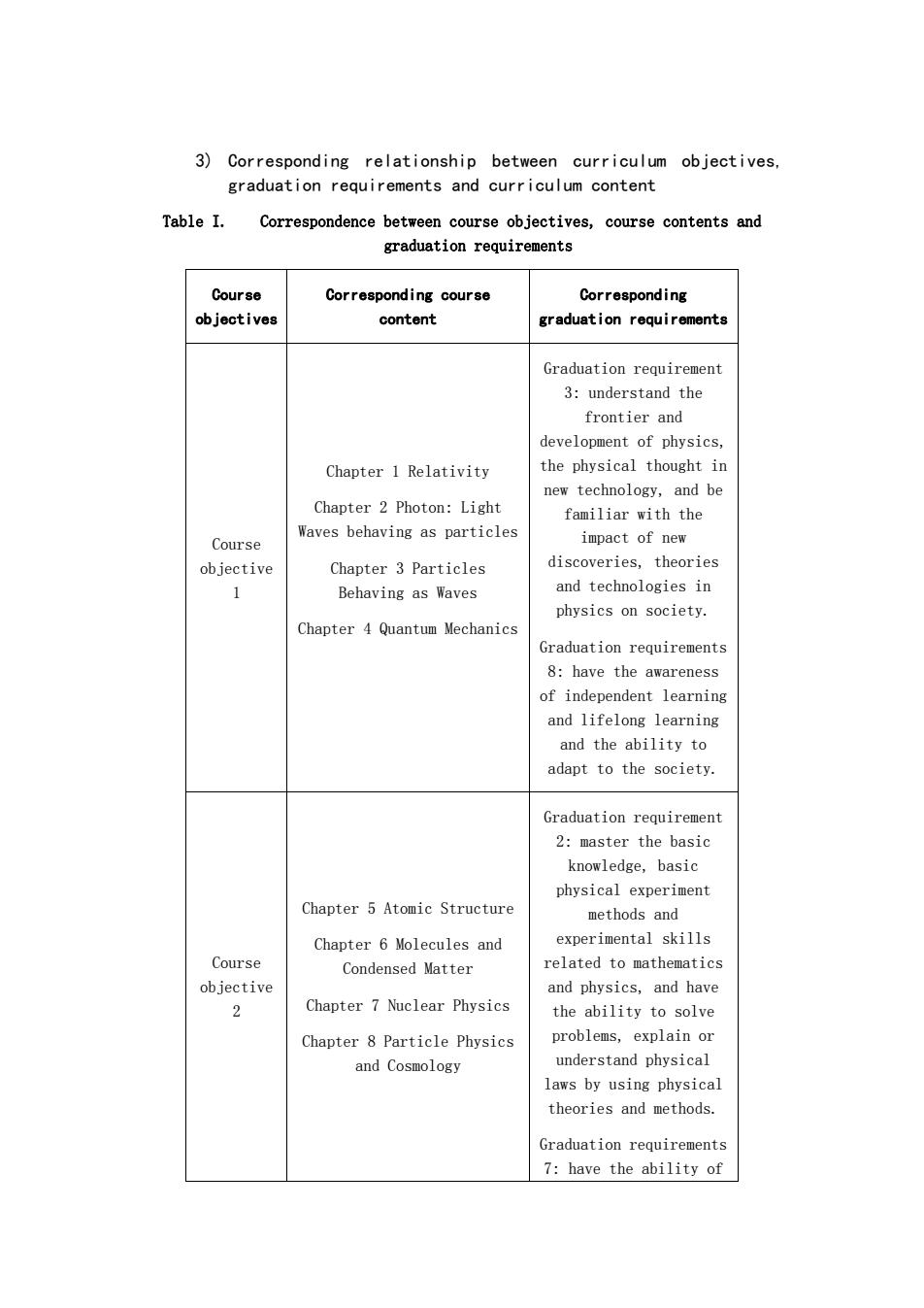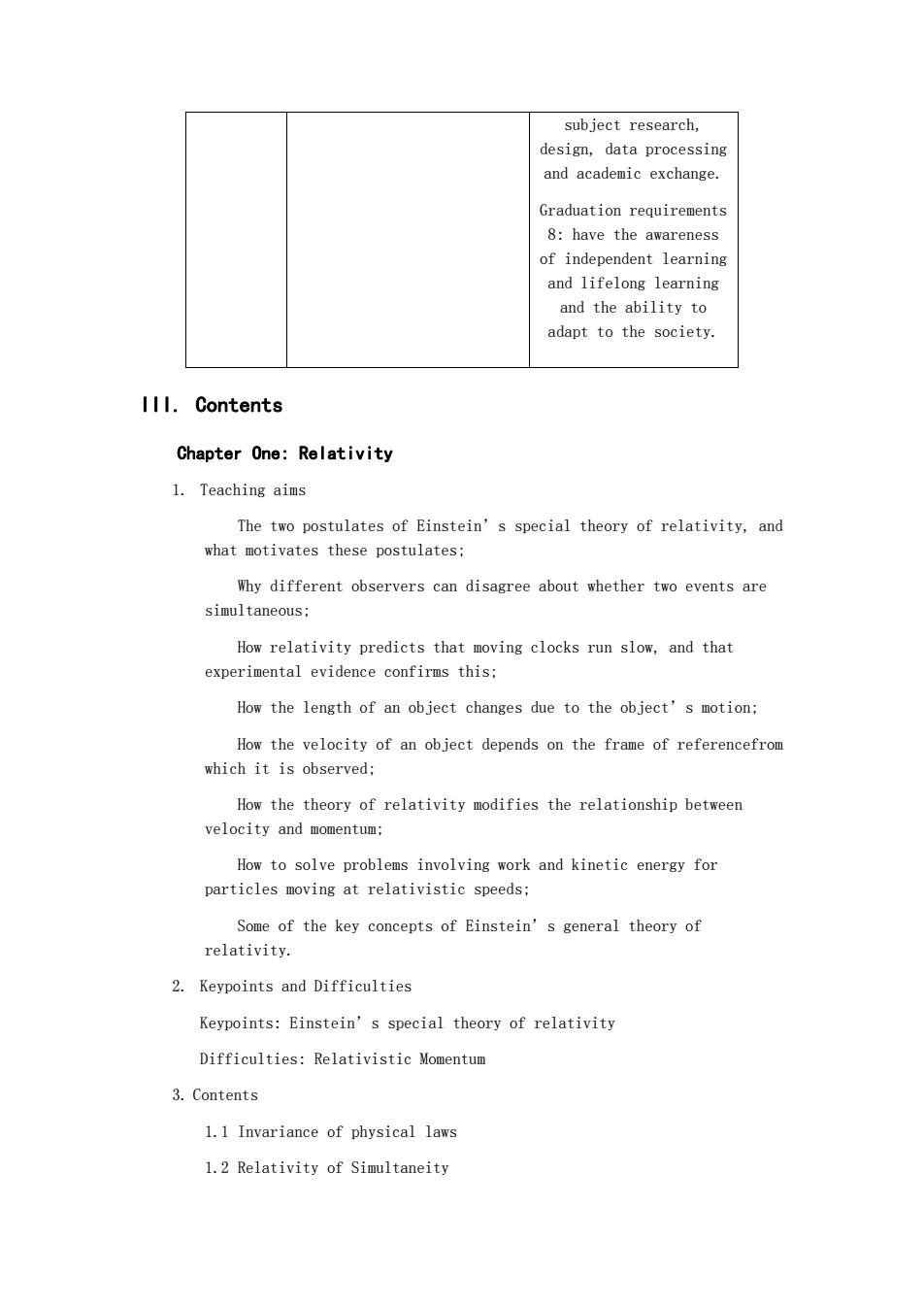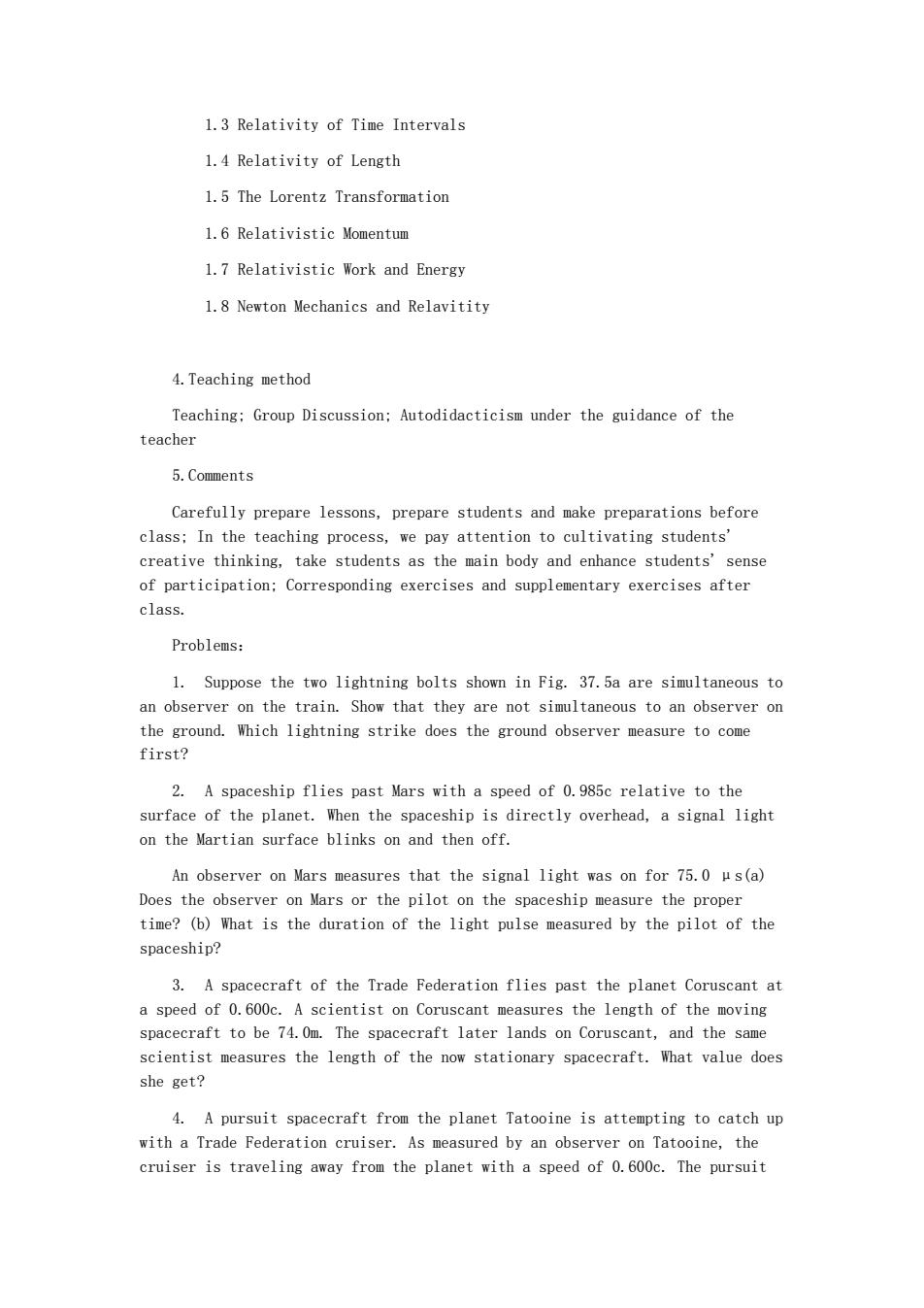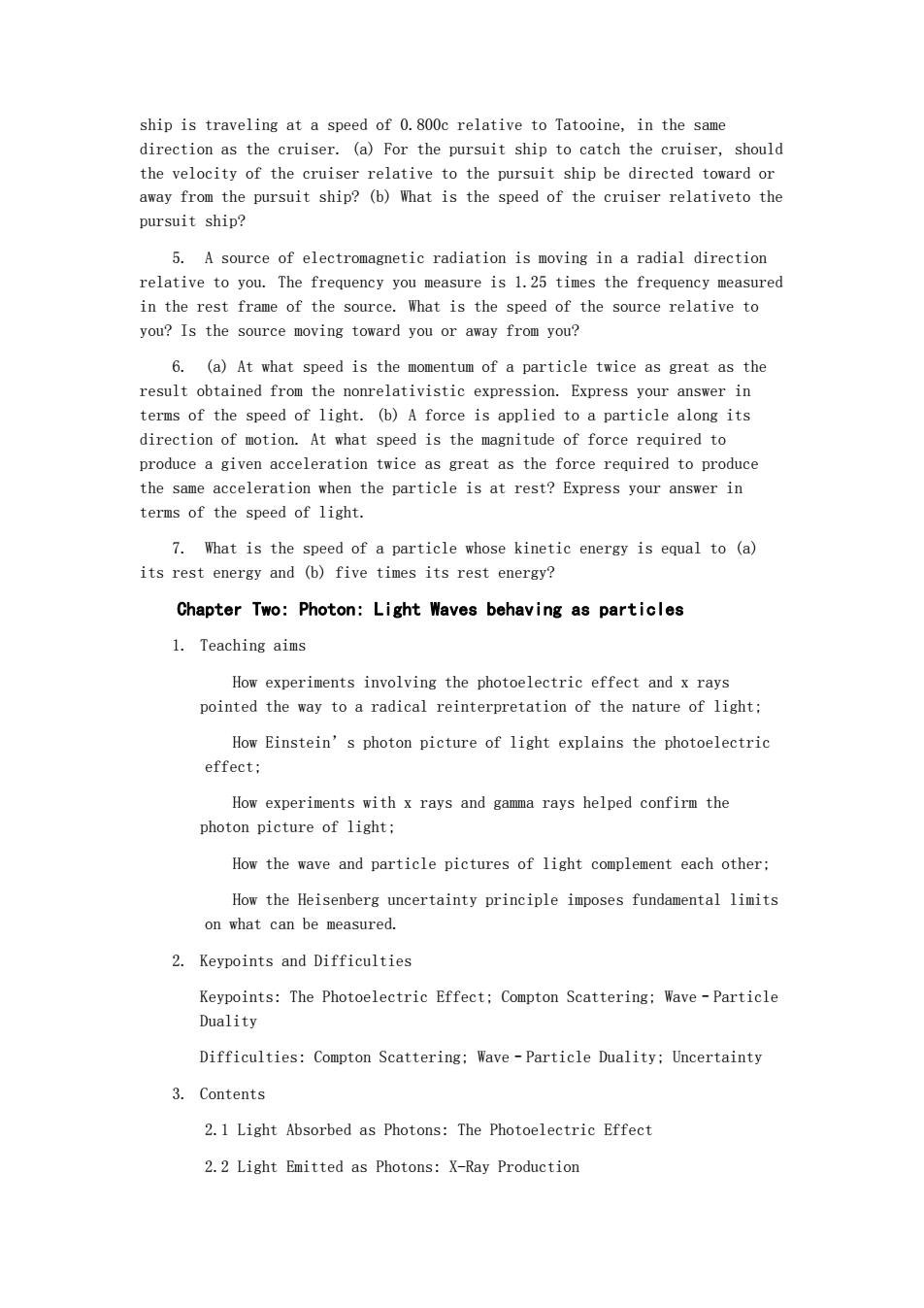
"Modern Physics"Course Syllabus 《现代物理学(英文)》课程教学大纲 1. Basic Information Name Modern Physics Course Code PHYS1027 Course Category Required coursed Majors Physics Credit Total Hours 54 ianvi cai(蔡田恰 Instructors Date 2021.9 Sheng Ju(睢胜) Textbooks Hugh D.Young and Roger A.Freedman,Sears and Zemansky's University Physics with Modern Physics,13th Edition,Pearson Education,2010 1I.Teaching aim 1)Overall objectives: Modern Physics encompasses the large and the small,the old and the new Frm theato to galaxies,fro cireuitry to erodynamics. physics is very much a part of the world around us.The sutudents probably are taking this introductory course in calculus based physics because it is required for subsequent courses you plan to take in preparation for a career in science or engineering.The teacher wants the students to learn physics and to enjoy the experience. Modern Physics is a branch of physics including relativity,quantum physics, and their applications. 2)Course objectives: 1.Basic concepts of relativity and quantum mechanics including relativity. quantization of charge,light,and energy,the nuclear atom,the wavelike properties of particles and the Schrodinger Equation. 2.Application of quantum mechanics and relativity including molecular structure. spectra solid state physics,nuclear physics,particle physics astrophysics and cosmology
“Modern Physics” Course Syllabus 《现代物理学(英文)》课程教学大纲 I. Basic Information Name Modern Physics Course Code PHYS1027 Course Category Required coursed Majors Physics Credit 3 Total Hours 54 Instructors Tianyi Cai(蔡田怡) Sheng Ju(雎胜) Date 2021.9 Textbooks Hugh D. Young and Roger A. Freedman,Sears and Zemansky’s University Physics with Modern Physics,13th Edition, Pearson Education, 2010 II. Teaching aim 1) Overall objectives: Modern Physics encompasses the large and the small, the old and the new. From the atom to galaxies, from electrical circuitry to aerodynamics, Modern physics is very much a part of the world around us. The sutudents probably are taking this introductory course in calculus based physics because it is required for subsequent courses you plan to take in preparation for a career in science or engineering. The teacher wants the students to learn physics and to enjoy the experience. Modern Physics is a branch of physics including relativity, quantum physics, and their applications. 2) Course objectives: 1. Basic concepts of relativity and quantum mechanics including relativity, quantization of charge, light, and energy, the nuclear atom, the wavelike properties of particles and the Schrodinger Equation. 2. Application of quantum mechanics and relativity including molecular structure, spectra solid state physics, nuclear physics, particle physics astrophysics and cosmology

3)Corresponding relationship between curriculum objectives graduation requirements and curriculum content Table I. Correspondence between course objectives,course contents and graduation requirements Course Corresponding course Corresponding objectives content graduation requirements Graduation requirement 3:understand the frontier and development of physics, Chapter 1 Relativity the physical thought in new technology,and be Chapter 2 Photon:Light familiar with the Waves behaving as particles Course impact of ne ob iective Chapter 3 Particles discoveries,theories Behaving as Waves and technologies in physics on society. Chapter 4 Quantum Mechanics Graduation requirement 8:have the avareness of independent learning and lifelong learning and the ability to adapt to the society. Graduation requiremen 2:master the basic knowledge.basic ohysical experiment Chapter 5 Atomic Structure methods and Chapter 6 Molecules and experimental skills Course Condensed Matter related to mathematics objective and physics.and have 2 Chapter 7 Nuclear Physics the ability to solve Chapter 8 Particle Physics problems,explain or and Cosmology aws by using physica theories and methods. Graduation reauirements 7:have the ability of
3) Corresponding relationship between curriculum objectives, graduation requirements and curriculum content Table I. Correspondence between course objectives, course contents and graduation requirements Course objectives Corresponding course content Corresponding graduation requirements Course objective 1 Chapter 1 Relativity Chapter 2 Photon: Light Waves behaving as particles Chapter 3 Particles Behaving as Waves Chapter 4 Quantum Mechanics Graduation requirement 3: understand the frontier and development of physics, the physical thought in new technology, and be familiar with the impact of new discoveries, theories and technologies in physics on society. Graduation requirements 8: have the awareness of independent learning and lifelong learning and the ability to adapt to the society. Course objective 2 Chapter 5 Atomic Structure Chapter 6 Molecules and Condensed Matter Chapter 7 Nuclear Physics Chapter 8 Particle Physics and Cosmology Graduation requirement 2: master the basic knowledge, basic physical experiment methods and experimental skills related to mathematics and physics, and have the ability to solve problems, explain or understand physical laws by using physical theories and methods. Graduation requirements 7: have the ability of

subject research. Graduation requirements 8:have the awareness of independent learning and lifelong leaing and the ability to adapt to the society. 111.Contents Chapter One:Relativity 1.Teaching aims The two postulates of Einstein's special theory of relativity,and what motivates these postulates Why different observers can disagree about whether two events are simultaneous: How relativity predicts that moving clocks run slow.and that experimental evidence confirms this: How the length of an object changes due to the object's motion: How the velocity of an object depends on the frame of referencefrom which it is observed: How the theory of relativity modifies the relationship betweer velocity and momentum: How to solve problems involving work and kinetic energy for particles moving at relativistic speeds: Some of the key concepts of Einstein's general theory of relativity. 2.Keypoints and Difficulties Keypoints:Einstein's special theory of relativity Difficulties:Relativistic Momentum 3.Contents 1.1 Invariance of physical laws 1.2 Relativity of Simultaneity
subject research, design, data processing and academic exchange. Graduation requirements 8: have the awareness of independent learning and lifelong learning and the ability to adapt to the society. III. Contents Chapter One: Relativity 1. Teaching aims The two postulates of Einstein’s special theory of relativity, and what motivates these postulates; Why different observers can disagree about whether two events are simultaneous; How relativity predicts that moving clocks run slow, and that experimental evidence confirms this; How the length of an object changes due to the object’s motion; How the velocity of an object depends on the frame of referencefrom which it is observed; How the theory of relativity modifies the relationship between velocity and momentum; How to solve problems involving work and kinetic energy for particles moving at relativistic speeds; Some of the key concepts of Einstein’s general theory of relativity. 2. Keypoints and Difficulties Keypoints: Einstein’s special theory of relativity Difficulties: Relativistic Momentum 3. Contents 1.1 Invariance of physical laws 1.2 Relativity of Simultaneity

1.3 Relativity of Time Intervals 1.4 Relativity of Length 1.5 The Lorentz Transformation 1.6 Relativistic Momentum 1.7 Relativistic Work and Energy 1.8 Newton Mechanics and Relavitity 4.Teaching method Teaching:Group Discussion;Autodidacticism under the guidance of the teacher 5.Comments Carefully prepare lessons,prepare students and make preparations before class:In the teaching proce we pay attention to cultivating students' creative thinking, take students as the main body and emhance studentsse of participation:Corresponding exercises and supplementary exercises after class. Problems: 1.Suppose the two lightning bolts shown in Fig.37.5a are simultaneous to an observer on the train.Show that they are not simultaneous to an observer on the ground.Which lightning strike does the ground observer measure to come first? 2.A spaceship flies past Mars with a speed of 0.985c relative to the surface of the planet.Whe the spaceship is directly overhead,a signal light on the Martian surface blinks on and then off. An observer on Mars measures that the signal light was on for 75.0 us(a) Does the observer on Mars or the pilot on the spaceship measure the proper time?(b)What is the duration of the light pulse measured by the pilot of the spaceship? 3.A spacecraft of the Trade Federation flies past the planet Coruscant at a speed of 0.600c.A scientist on Coruscant measures the length of the moving spacecraft to be 74.0m.The spacecraft later lands on Coruscant,and the same scientist measures the length of the now stationary spacecraft.What value does she get? 4.A pursuit spacecraft from the planet Tatooine is attempting to catch up with a Trade Federation cruiser.As measured by an observer on Tatooine,the cruiser is traveling away from the planet with a speed of 0.600c.The pursuit
1.3 Relativity of Time Intervals 1.4 Relativity of Length 1.5 The Lorentz Transformation 1.6 Relativistic Momentum 1.7 Relativistic Work and Energy 1.8 Newton Mechanics and Relavitity 4.Teaching method Teaching; Group Discussion; Autodidacticism under the guidance of the teacher 5.Comments Carefully prepare lessons, prepare students and make preparations before class; In the teaching process, we pay attention to cultivating students' creative thinking, take students as the main body and enhance students' sense of participation; Corresponding exercises and supplementary exercises after class. Problems: 1. Suppose the two lightning bolts shown in Fig. 37.5a are simultaneous to an observer on the train. Show that they are not simultaneous to an observer on the ground. Which lightning strike does the ground observer measure to come first? 2. A spaceship flies past Mars with a speed of 0.985c relative to the surface of the planet. When the spaceship is directly overhead, a signal light on the Martian surface blinks on and then off. An observer on Mars measures that the signal light was on for 75.0 μs(a) Does the observer on Mars or the pilot on the spaceship measure the proper time? (b) What is the duration of the light pulse measured by the pilot of the spaceship? 3. A spacecraft of the Trade Federation flies past the planet Coruscant at a speed of 0.600c. A scientist on Coruscant measures the length of the moving spacecraft to be 74.0m. The spacecraft later lands on Coruscant, and the same scientist measures the length of the now stationary spacecraft. What value does she get? 4. A pursuit spacecraft from the planet Tatooine is attempting to catch up with a Trade Federation cruiser. As measured by an observer on Tatooine, the cruiser is traveling away from the planet with a speed of 0.600c. The pursuit

ship is traveling at a speed of 0.800c relative to Tatooine,in the same relative ip be directed toward o away from the e pursuit ship?(b)What is the speed of the cruiser relativeto the pursuit ship? 5.A source of electromagnetic radiation is moving in a radial direction relative to you.The is1.times the in the rest frame of the source What is the speed of the source relativeto you?Is the source moving toward you or away from you? 6.(a)At what speed is the momentum of a particle twice as great as the result obtained from the nonrelativistic expression.Express your answer in terms of the speed of light.(b)A force is applied to a particle along its direction ofmo ion.At what eed is s the magnitude of force ired to produce a given acceleration twice as great as the force required to produce the same acceleration when the particle is at rest?Express your answer in terms of the speed of light. 7.What is the speed of a particle whose kinetic energy is equal to (a) its rest energy and (b)five times its rest energy? Chapter Two:Photon:Light Waves behaving as particles 1.Teaching aims How Einstein's photon picture of light explains the photoelectric effect: How experiments with x rays and gamma rays helped confirm the photon picture of light; How the wave and particle pictures of light complement each other: How the Heisenberg uncertainty principle imposes fundamental limits on what can be measured. 2.Keypoints and Difficulties Keypoints:The Photoelectric Effect:Compton Scattering:Wave-Particle Duality Difficulties:Compton Scattering:Wave-Particle Duality:Uncertainty 3.Contents 2.1 Light Absorbed as Photons:The Photoelectric Effect 2.2 Light Emitted as Photons:X-Ray Production
ship is traveling at a speed of 0.800c relative to Tatooine, in the same direction as the cruiser. (a) For the pursuit ship to catch the cruiser, should the velocity of the cruiser relative to the pursuit ship be directed toward or away from the pursuit ship? (b) What is the speed of the cruiser relativeto the pursuit ship? 5. A source of electromagnetic radiation is moving in a radial direction relative to you. The frequency you measure is 1.25 times the frequency measured in the rest frame of the source. What is the speed of the source relative to you? Is the source moving toward you or away from you? 6. (a) At what speed is the momentum of a particle twice as great as the result obtained from the nonrelativistic expression. Express your answer in terms of the speed of light. (b) A force is applied to a particle along its direction of motion. At what speed is the magnitude of force required to produce a given acceleration twice as great as the force required to produce the same acceleration when the particle is at rest? Express your answer in terms of the speed of light. 7. What is the speed of a particle whose kinetic energy is equal to (a) its rest energy and (b) five times its rest energy? Chapter Two: Photon: Light Waves behaving as particles 1. Teaching aims How experiments involving the photoelectric effect and x rays pointed the way to a radical reinterpretation of the nature of light; How Einstein’s photon picture of light explains the photoelectric effect; How experiments with x rays and gamma rays helped confirm the photon picture of light; How the wave and particle pictures of light complement each other; How the Heisenberg uncertainty principle imposes fundamental limits on what can be measured. 2. Keypoints and Difficulties Keypoints: The Photoelectric Effect; Compton Scattering; Wave–Particle Duality Difficulties: Compton Scattering; Wave–Particle Duality; Uncertainty 3. Contents 2.1 Light Absorbed as Photons: The Photoelectric Effect 2.2 Light Emitted as Photons: X-Ray Production